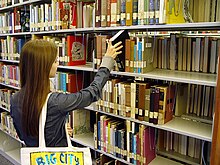Bookend
The term bookend refers to a device with which books are fixed in place on a bookshelf so that they cannot fall over. If a book falls over , similar to the domino effect , neighboring books and other objects on the shelf can fall over or even fall down and be damaged in this way. Therefore, it makes sense to at least fix the outer books in a group of books.
Categories
Bookends hold books in place in three different ways:
- Bookends can support the books by the weight of the books themselves. These include right-angled metal or plexiglass angles , on the underside of which the books are placed. These are usually the simplest forms of bookends.
- Bookends can support the books by the weight of the bookend. These include, for example, quarter spheres or weighted angles decorated with objects.
- Bookends can support the books by attaching the bookends to the shelf. This includes panels clamped or otherwise attached to the shelf at a right angle.
Bookends in librarianship
There are two basic systems of bookends that are widely used in today's German libraries - on the one hand, the hanging bookends integrated into the bottom of the shelves of the bookcases; on the other hand, angular bookends equipped with a sliding edge. The "Principles for equipping public libraries" provide for one bookend per shelf and per classification point or 1.5 bookends per shelf.
Well-known manufacturers
Jakob Maul GmbH is one of the largest German manufacturers of bookends .


